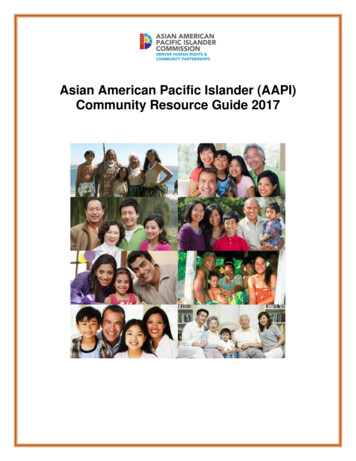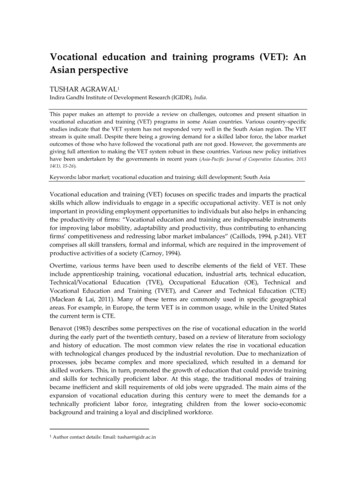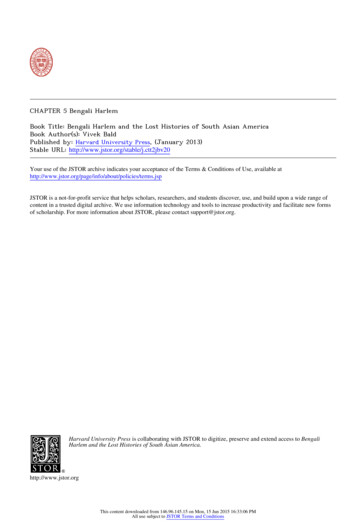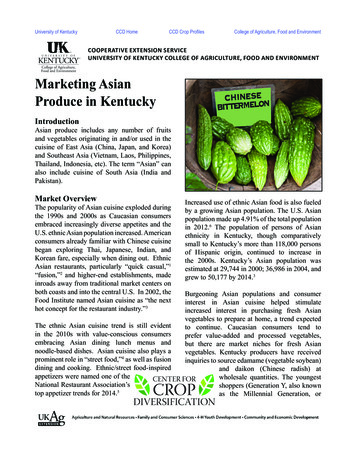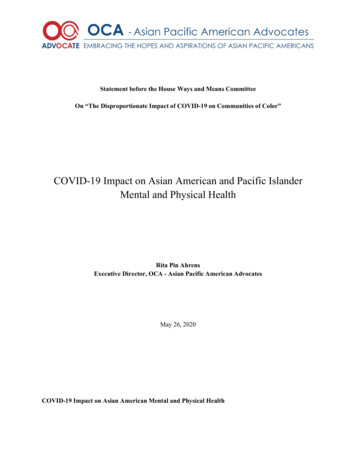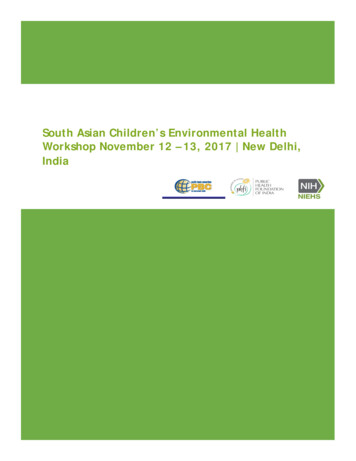
Transcription
South Asian Children’s Environmental HealthWorkshop November 12 – 13, 2017 New Delhi,India
ContentsGlossary . 2Day 1 Welcome . 3Introductions. 3Presentation of Country Reports . 3CEH in India. 3CEH in Bangladesh . 4CEH in Nepal . 5CEH in Bhutan . 6CEH in Vietnam . 7CEH in Thailand. 8CEH in Sri Lanka . 9Day 2 Welcome . 11Summary of Day 1 Discussions . 11Collaboration Between Ministries in Sri Lanka . 11Coordinated Approaches to Children’s Environmental Health. 12Professor Reddy Visit . 14WHO Global Plan of Action . 14Final Remarks . 17Appendix 1: Attendees. 191
GlossaryANC:Antenatal CareLMIC:Low- and Middle-Income CountryNCD:Noncommunicable DiseasePBDE:Polybrominated Diphenyl EtherPAH:Polycyclic Aromatic HydrocarbonSDG:United Nations Sustainable Development GoalWASH:Water, Sanitation, and Hygiene2
Day 1 WelcomeWilliam Suk, Ph.D. (NIEHS) and Sathiarany Vong, M.D. (Ministry of Health, Cambodia)Suk welcomed attendees and noted that the goal of the workshop was to determine the feasibility offurther networking and collaborating among children’s environmental health (CEH) researchers. He alsonoted, “We can’t do this by ourselves. We have to do it in a cooperative and collaborative way.”Vong echoed Suk and stated, “We are here to establish a strong network in the Southeast Asia region tofree our children of environmental worries. Children are our future; they are the heart of theSustainable Development Goals (SDGs) and will inherit our legacy of policy and technology. The future ofour children is in our hands.”Vong provided an overview of children’s health in Cambodia and noted that under-5 fatalities havedeclined in Cambodia since 2004 and continue to do so. “However, it remains unacceptable based onneighboring countries,” she said. In Cambodia, more than 169/100,000 deaths are due to theenvironment, one of the highest in the Southeast Asia region following Laos and Myanmar.IntroductionsSee Appendix 1 for a list of attendees.Presentation of Country ReportsCEH in IndiaBeerappa Ravichandran, Ph.D. (National Institute of Occupational Health)Summary of Health in IndiaThere are a number of health threats to children in India related to the environment, including indoorair pollution and outdoor air pollution from both industries and traffic; small-scale industries thatgenerate nanoparticles that are dangerous; and high rates of use of generators that release dieselparticulate, including in homes.CEH Risks and ExposuresNIOH is conducting a study of “rag pickers” in Bangalore as part of their effort to collect data on childrenin the informal waste disposal and recycling sector. Children collect and sell recyclable parts that havean economic value, including aluminum, batteries, etc. Whole families collect waste together, in poorliving conditions near dumping sites that have toxins, chemicals, etc., and the children are particularlyvulnerable. There is an added social dynamic, where children and families move as large groups and are“territorial” about their areas of collection. The study has found that these children have poor hygieneand nutrition; are exposed to waste materials; and commonly have leg injuries, gastrointestinalinfections, skin diseases, and rabies (because of stray dogs). Other research has found polychlorinateddibenzodioxins (PCDDs) and polychlorinated dibenzofurans (PCDFs) at dumping sites at levels thatexceed guidelines. The risk of cancer, particularly due to polycyclic aromatic hydrocarbons (PAHs) andleachate from landfills, is high. Additional findings of tuberculosis, bronchitis, asthma, and pneumoniahave been reported.3
Children in rural areas often work in agriculture, and for many, they work as unpaid labor for their ownfamily. Pesticide exposures, particularly when it is mixed within the home, are a major health risk.Children often work in “nonhazardous” roles (such as plucking flowers), but organophosphate exposurecauses neurological symptoms even at low doses, and families often cannot afford for children not towork. Children often work in fields before school, even if they do attend. This sometimes coincides withearly morning pesticide applications and, thus, exposures. Children often don’t use gloves and thereforehave dermal exposure, which is compounded by them taking their food with them and not washinghands before eating, thus increasing exposure.Another NIOH study is looking at sheep farming. Sheep wool is used for carpets, but children are oftennearby and the dust and proteins from sheep wool is inhaled. The study team has found DDT and otherpesticides on the family, including the children in the house.Brick kilns remain a major health and occupational safety challenge in India. The government bannedchild labor in the industry, but sometimes children work with their family and work there anyway.Children also work in extremely dangerous stone quarries. Even when children don’t work in stonequarries, parents often are exposed to high levels of silica dust and many parents bring children to work(due to young age, lack of school, etc.). Mining and quarries are very noisy areas and noise-inducedhearing loss is common, even in children.Research Needs and ChallengesRavichandran noted that there is a continued need to facilitate further knowledge exchange withresearchers, to continue to build capacity in researchers, and to share intervention methodologies andbest practices.CEH in BangladeshShahir Hossain, Ph.D. (EDSO)CEH Risks and ExposuresAir pollution is a serious issue in Bangladesh and in all of Asia. Air pollution issues get the most attentionin Delhi or Dhaka, but rural air pollution remains a major problem. Mothers and children are impactedby indoor air pollution. The link between death rates and exposures is often air pollution.The collection of waste in Bangladesh is “totally horrible” and all waste is collected together anddumped, mostly taken to a landfill. Landfills are hazardous and children who are “waste pickers” areoften at the landfill. Hossain noted, “Everyone sees it every day, but no one will discuss the issue of howwaste impacts children.”Lead paint and lead poisoning is a major issue in Asian countries. In 2012, seven different organizationsin Asia started a lead-free paint project. Bangladesh, Nepal, Sri Lanka, the Philippines, India, andIndonesia are part of the effort. In many of these countries, manufacturers have reduced lead use andare moving to zero lead paint. But the problem is that while the regulation is good on paper, it requiresenforcement. Due to lack of transparency, corruption, etc., the political commitment to enforcement islacking and “it doesn’t really work.”4
Toxic toys are an under-reported issue. Tests of toys sold in Bangladesh have found lead, cadmium,bromine, and chromium in toys (some at levels more than 97 percent above the EU ceiling). This is aserious issue and a serious environmental health issue. In one test, a Rubik’s cube from Bangladesh wasfound to have OctaBDE (a chemical banned under the Stockholm Convention). Most of the unsafe toysare produced by China, Thailand, and India. The products are spreading all over Asia, even beyondcountries where the toys are produced. Children’s cosmetics and toy jewelry have also been found tohave elevated rates of harmful substances. EDSO found arsenic in baby lotion, and titanium dioxide issometimes found in kids jewelry items.Child labor and occupational hazards for children remain a major issue in Bangladesh. Children work intanneries and are exposed to heavy metals (lead, cadmium, mercury). Bangladesh has 50,000 childrenworking in e-waste and informal recycling. Shipbreaking is a major industry in Bangladesh, but theshipbreaking yard is a “killing field” and many children work there and are exposed to heavy toxic metalsfrom e-waste and ships.CEH in NepalHari Dott Joshi (Yeti Health Science Purbhaanchal University)Summary of Health in NepalThe average life expectancy in Nepal is 66.6 years. The infant mortality rate is 55/1,000 live births inrural areas and 38/1,000 live births in urban areas. The under-5 mortality rate is 64/1,000 live births inrural areas and 45/1,000 live births in urban areas.CEH Risks and ExposuresIndoor and outdoor air pollution are major risks for children. Sixty-four percent of indoor cooking isdone with firewood and 10 percent of households burn cow dung. This is particularly problematic in themountainous areas of the country where there is limited/no ventilation in the home due to cold outdoortemperatures. A recent study found that many children are exposed to high levels of PM10 and PM2.5 formore than five hours per day. The same study found correlations with eye issues, and respiratoryailments associated with these exposures. Ambient air pollution, particularly in Kathmandu, is a majorchallenge. Pollution comes from brick laying, construction projects, and vehicles. The pollution is sodangerous that there is a government campaign to encourage people to NOT walk in the mornings inthe Kathmandu valley. This pollution is particularly a threat to children walking to school in themornings.Water, sanitation, and hygiene (WASH) challenges remain major threats to CEH. Forty-eight percent ofhouseholds have safe drinking water in Nepal. Fifteen percent of households practice open defecationor have no sanitation facility, while 38 percent have unimproved sanitation. There is limited systemicsurveillance of water quality and many studies have found varying levels of unsafe water andcontaminants. There is a government policy of having one toilet for every 50 students in school,however the reality is that there are usually 127 students for every one toilet. Lack of toilet facilities hasbeen shown to reduce female school attendance and therefore female literacy. There is a correlationbetween toilets in schools and female literacy across Nepal.5
Additional exposure risks to children in Nepal include child labor in brick laying and similar industries,lead pollution, and climate change. All five major vector-borne diseases are now endemic in Nepal andthere has been an observed shift in the range of vectors to 2,000 meters above sea level. Cold wavesare a new issue in Nepal with an observed 5 percent increase in the incidence of Acute RespiratoryInfection (ARI) in cold months. ARI deaths have been observed to increase by 2.68 percent for every 1degree Celsius decrease in the daily minimum temperature.CEH Policies in NepalHealth is noted in the new 2016 Constitution of Nepal. The National Health Policy of 2014 and NationalWater Supply and Sanitation Policy of 2014 are relevant to CEH issues. Nepal also has a climate changepolicy from 2011, and national improvement plans for WASH and for the health sector have beenestablished. Implementation of most policies is overseen by the Ministry of Health, however childwelfare is governed by the Ministry of Women, Children and Social Welfare.Challenges to Improving CEH in NepalLack of coordination among government organizations and implementation are continued challenges toimproving CEH, as is weak enforcement of existing policies. Some health interventions required a changein cultural practices and behavior, such as the relationship between preferred household design andindoor cookstove use. Geographic challenges make delivery of care difficult, and compound thecomplexity of disasters, deforestation, and climate change.CEH in BhutanChador Wangdi (Ministry of Health, Bhutan)Summary of Health and Population in BhutanThe total population of Bhutan is less than 1 million people. Seventy percent of the country is forested,and 58 percent of the population is dependent on agriculture. There is a constitutional mandate that 60percent of the country retain a forest cover. While policies exist, some are “paper tiger” and notenforced. Ninety-five percent of the population has access to improved drinking water, and 70 percenthas access to improved sanitation. More than 40 percent uses solid fuel for heating and cooking. Theleading causes of disease in children under 5 in Bhutan are respiratory diseases, skin diseases, diarrhea,and digestive system diseases.CEH Risks and ExposuresAir pollution is a major threat to children’s health. In Bhutan, 95 percent of the population has access toelectricity, but 40 percent of population lives in a house where solid fuel is used for cooking. There is apreference for wood style cooking and its flavor, particularly in rural areas where solid fuel is used bymore than 53 percent of the population. In many of these homes, women carry the children on theirback when cooking, thus increasing cooking-related indoor air exposures. Winter heating in traditionalhomes and rural areas is also done by burning wood. Some urban areas continue to use traditionalstoves and kerosene heaters during winter, and 2011 was first time air was found to exceed ambient airquality standards due to fuel burning in winter.6
Statistics for improved drinking water coverage and sanitation have improved throughout the country,however diarrhea and waterborne disease remains a leading cause of under-5 diseases. There remains abehavioral preference for open defecation in some areas, despite the presence of improved sanitationfacilities.Stunting in children has decreased significantly but remains in rural areas and the eastern region of thecountry. Anemia remains common in children under 5 in Bhutan. While rates have declined, more than43 percent of children are anemic. Pregnant women have good health coverage, with many attendingprenatal visits and with anemia rates lower than those of nonpregnant women. However, only 52percent of pregnant women see prenatal care in the first trimester. Breastfeeding rates are high, withnearly half of women reporting exclusive breastfeeding. Upon weaning from breastfeeding, there isreported low dietary diversity for introduced complementary foods, with a low percentage of childrenbeing given iron rich foods at ages 6-23 months. The Ministry of Health is seeking to distribute nutritionpowder to health centers, particularly where iron rich foods are less available.There is no segregation or treatment of waste. Informal waste collectors sort and re-sell scraps fromwaste. The capital, Thimphu, generates nearly 50 tons of waste per day and it is all dumped into onelandfill only 12 kilometers from the city. None of the waste is segregated, sorted, or recycled. Leachingof chemicals and fires (accidental and intentional) at landfills contribute to air and water pollution.Very few chemicals are manufactured in the country. Most chemical products are imported from India.Pesticides are used often, and asbestos is commonly used and found in many areas. There is no regularmonitoring data on carcinogens, and there is a general lack of awareness of carcinogenic substances andno separate legislation to deal with carcinogenic chemicals.Research Needs and ChallengesPresently there are no studies specific to Bhutan that explore the correlation between air pollution andrespiratory/eye diseases.CEH in VietnamLe Thai Ha (National Institute of Occupational and Environmental Health)Summary of Health and Population in VietnamThere are 26 million children under 16 in Vietnam. There are increasing health disparities between Kinhmajority individuals and ethnic minorities, between urban and rural residents, and between those inmountainous areas of the country compared to the lower delta areas. Child poverty is very high in thenorthern mountains, and in Vietnam 40 percent of poor children live in rural areas. About 50 percent ofrural children attend pre-school, whereas 75 percent of urban children do.The under-5 mortality rate in Vietnam is 20.2/1,000 live births and diarrhea is the leading cause ofunder-5 death (10 percent of U5 deaths). Additional diseases commonly impacting children includedengue fever and hand, foot, and mouth disease.7
CEH Risks and ExposuresVietnam has high rates of children without access to clean water, reaching upwards of 80 percent in theHighlands and Mekong River Delta. Fifty-three percent of schools don’t provide drinking water forstudents during school hours. Seventy-three percent of schools have latrines, however more than 50percent are estimated to not meet sanitation standards.Neglected tropical diseases, including soil-transmitted helminthiasis (STH), are a major threat tochildren’s health. Sixty-seven million people live in STH endemic areas and school-aged children are themost at risk. In some areas, infection is as high as 86 percent of the population. Leading contributors tohigh rates are lack of sanitation, use of human compost in agriculture, barefoot walking, andconsumption of raw vegetables.Lead poisoning in children remains a problem. Sources of lead exposure include lead mines; industrialproduction; recycling “villages” (where a majority of industry dismantles lead batteries); the use oftraditional drugs, and lead and lead paint in toys. Lead battery recycling used to be common inresidential areas, however new policies have moved activities to an industrial zone. A study in therecycling village of Dong Mai found blood lead levels of children in excess of 45 ug/dL (which usually istreated with chelation). After an intervention in the village, no children were found to have levels inexcess of 45 ug/dL and the average level was reduced to 14.63 ug/dL. Children’s blood lead levels havealso been found to be elevated near lead mines in the country.Chronic arsenic contamination is common in many provinces and the main source of exposure is fromcontaminated groundwater. An NIOEH team studied a cohort of children exposed to arsenic fromgroundwater and found increases in neurobehavioral disorders, including anxiety.Research and Health Needs and ChallengesThere continues to be a need for sanitation and water in remote areas, but efforts to provide watermust address natural arsenic contamination as well. A study on the effects of arsenic exposure onphysical development, mental health in children, and genetic polymorphisms related to arsenicmetabolism would be welcomed.STH reduction measures must include treatment, clean water, and behavior change. A study is alsoneeded to understand what is effective and can help maintain control of STH.There is a continued need to reduce lead poisoning in children. In doing so, efforts must includeeducation, worker protection (for those in mines and high-risk environments), and continued monitoringof interventions. Research is still needed in villages with similar issues to Dong Mai to explore measuresthat may prevent children’s exposure.CEH in ThailandUbon Cha’on, Ph.D. (Khon Kaen University)Summary of Health in ThailandNeonatal and child mortality is low in Thailand, with a neonatal mortality rate of 3.5/1,000 live birthsand an under-5 mortality rate of 8.6/1,000 live births. Eight percent of live births are diagnosed with8
congenital anomalies (the five most common birth defects in Thailand include congenital heart defect,limb abnormalities, cleft lip and palate, Down syndrome, and congenital hydrocephalus).CEH Risks and ExposuresThai women don’t breastfeed at the rates of many other neighboring countries and often breastfeed fora shorter duration of time. An estimated 16 percent of children are stunted, yet Thailand has the fastestincreasing rate for childhood obesity in the world. There is a high prevalence of junk food consumed(food high in calories and fat) and soft drinks and sugary coffee are common in children’s diets.Glyphosate and paraquat are commonly used in agriculture and have been found in high rates inmaternal and fetal serums. Pesticides are commonly used on fruits and vegetables, as growers like touse toxicants to protect crops from insects.Flooding is a major threat to children’s health and in addition to threats usually associated with floods,schools often don’t have clean water after floods and thus if open, are not safe for children.Chronic kidney disease of unknown etiology (CKDu) is a growing problem. The relationship betweenCKDu and water is being investigated.CEH in Sri LankaInoka Suraweera, M.D. (Ministry of Health, Sri Lanka)Summary of Health and Population in Sri LankaThe total population of Sri Lanka is 21 million people and 77percent of children live in rural areas. The under-5 mortality rate is10/1,000 live births and the infant mortality rate is 8/1,000 livebirths. It is important to note that while the infant mortality ratehas declined, the majority of under-5 deaths are neonatal.Congenital malformations are the most significant cause ofneonatal death and there are not yet studies to understand theenvironmental associations in Sri Lanka.“We need healthy children, and if youhave healthier children, you have ahealthier nation.”-Inoka Suraweera, Ministry ofHealth, Sri LankaCEH Risks and ExposuresOutdoor air pollution has increased in Sri Lanka and the increase is correlated to an increase in privatevehicle sales. Open burning of plastics generates dioxins, etc. due to lack of formal waste disposal and isa common contributor to outdoor air pollution. Estimates have noted that indoor air pollution remains alarger threat than outdoor air pollution in Sri Lanka (as of 2014), however data specific to Sri Lanka islimited. Nearly 60 percent of the population uses biomass fuel for indoor cooking in Sri Lanka. Thehighest use of biomass is in rural areas, where an estimated 86 percent of the population uses firewood.Poor ventilation, the absence of chimneys, and the practice of using polytene (plastic bags) to initiate afire all contribute to indoor air pollution. Unlike other countries in the region, heating is rarely acontributor to indoor air pollution due to the warm natural climate. A World Bank study in Sri Lankafound that indoor air pollution is a predictor of diabetes among adults, and is a predictor of stunting,underweight, and wasting in children under 5.9
Ninety percent of mothers breastfeed for six months and more than 97 percent of deliveries areinstitutional. More than 10 percent of the population has diabetes and the proportion is expected toincrease. A recent study found that 38 percent of children aged between 10-14 years were obese and 20percent overweight. More and more children are exposed to dietary factors, sedentary behaviors, andunhealthy habits. There remains, however, a double burden of nutritional problems in Sri Lanka as bothmalnutrition and obesity are increasing.Many industries have no proper disposal mechanisms for waste or chemicals and inappropriate use ofagricultural chemicals is common. More than 80 percent of workers in the country work in theagricultural sector and there is limited to no PPE use while synthetic pesticide usage, particularlyherbicides, is increasing. CKDu is a major problem, which may be related to pesticide and chemical use.Dengue remains a major problem. Thirty percent of dengue patients in 2017 were 5-19 years old. In2017, there were more than four times the number of cases compared to the 2010 and 2016 average.The country has seen an increase in floods, droughts, and landslides, and children and families are oftenforced to move due to these events.“We can share and not reinvent thewheel and learn from others’Research and Health Needs and Challengesexperiences.”Improved surveillance to capture baseline data is needed, as isincreased research on the environment and children’s health,- Inoka Suraweera, Ministry ofparticularly understanding of early exposures on adult health.Health, Sri Lanka10
Day 2 WelcomeSummary of Day 1 DiscussionsBetsy Galluzzo and Brittany Trottier (NIEHS)Themes from country reports included many similar challenges and health risks, continued need forimproved access to WASH. The presence of policy is only useful if it is supported by enforcement and coordination betweengoverning agencies.o Disparities continue to make health gains uneven across gender, regions, geographiclocations, native populations, and urban and rural areas.Collaboration Between Ministries in Sri LankaInoka Suraweera, M.D. (Ministry of Health, Sri Lanka)“When it comes to environmental health and occupational Health (EOH), it is about working with othersectors. As far as the Ministry of Health (MOH) in Sri Lanka is concerned, we can’t work alone. In thingslike maternal-child health, the MOH can play a major role on theirBanning Plastic Bags in Sri Lankaown. But with environmental health, each ministry must ‘holdhands’ with the others to achieve objectives.”Plastic bags are produced in massiveamounts and can’t be recycled in SriIn Sri Lanka, the MOH is separate from Ministry of theLanka as there is not a properEnvironment (MOE). The MOH has identified a focal point for EOH.disposal mechanism. Some of theTo make change, “you need a focal point at MOH for EOH and youdiscarded bags become breeding sitesneed to develop their capacity.”for mosquitos that carry dengue.Suraweera thanked the Chulabhorn Research Institute for helpingOther times, people burn the bagsher development. Capacity goes beyond technical areas andoutside and inside the houses, toincludes good communication skills to help develop rapportstart the cooking firewood.between ministries. It is important to identify the focal point in theTo combat the issue, the Ministry ofMOE in each area. Beyond identifying the related content areathe Environment and Ministry of(climate change, waste, etc.), the role of the health sector alsoHealth collaborated and convenedneeds to be identified. In solid waste management the role ofthe meeting. The MOH highlightedhealth care is in awareness raising: “If you identify the role of thethe health impacts of dengue and theMOH in each area, it becomes easier to discuss.” Once work starts,risks of burning plastics and indoor airthe input of the MOH to MOE decisions, and of MOE on MOHpollution.decisions, is important and carries weight. The health justificationshelp make the case.A committee was formed andprepared a Cabinet paper outliningShe shared an example of this related to plastic bags (see box atthe reasons for the suggested ban.right). To implement the ban, different ministries with differentThe ban went into effect inpriorities had to collaborate. Often, such as the case with plasticSeptember 2017.bags, the health justification is a major factor that can “helpconvince the other ministries to achieve major objectives.”Environment and health priorities can be competing with other priorities, but if committed a system isestablished it will move along.11
Suraweera also emphasized the need to work with the community and at the grassroots level: “Whatwe plan at the national level has to be implemented by the grassroots teams. They will take the servicesof each program to the communities. We have also strengthened district level capacity. We do annualenvironmental reviews and we invite the regional people to the review, so they hear other problemsand understand the need to work together. This helps build rapport for health and the environment.”Suraweera concluded by noting that “Sri Lanka is a small country, so it’s [collaboration] not so hard. Butit might be more difficult in a large country.”DiscussionThe following questions were raised during the discussion: Are you using local research or global data?What is “enough” for the justifications you need for policy?Suraweera responded, “I look at the global research, but we do have studies, particularly on denguebreeding. The plastics impacts we need to do more researc
CEH Risks and Exposures NIOH is conducting a study of "rag pickers" in Bangalore as part of their effort to collect data on children in the informal waste disposal and recycling sector.

